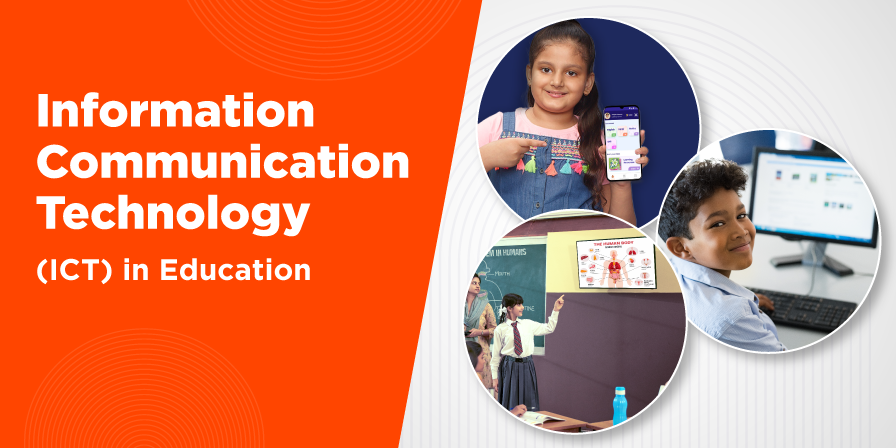What does a LEAD Powered School's classroom look like?
Understanding ICT in Education: Meaning, Role, and Importance in Learning

Understanding ICT in Education: Meaning, Role, and Importance in Learning
Last Updated On: 25/03/2025
Nitin Virmani
School Owner

“We need technology in every classroom and in every student and teacher’s hand, because it is the pen and paper of our time, and it is the lens through which we experience much of our world.” – David Warlick
ICT opens a world of possibilities for the betterment of the education sector. But before we learn of its benefits, we need to understand what is ICT in education management.
In this article

What is ICT in Education?

The Role and Importance of ICT in Education

LEAD Group - An integrated ICT solutions provider
Importance of ICT in Education for Modern Learning
ICT (Information and Communications Technology) encompasses tools and services that handle and communicate information, ranging from mobile phones to interactive whiteboards.
In education, ICT plays a crucial role by integrating digital tools into the learning environment, enhancing the teaching and learning experience. Whether it’s multimedia presentations, educational apps, or digital textbooks, ICT in education means leveraging technology to improve the delivery and effectiveness of education.
Technology in education isn’t something new, but not many have information about ICT in the education industry. This is because ICT comes with several constraints, one of which is ensuring access to electronic devices for every kid. But with more institutes investing in ICT, the problem should soon be resolved.
Never miss a story
Stay updated with the latest news and articles related to school education
GIVE YOUR SCHOOL THE LEAD ADVANTAGE
Importance of ICT in Education for Modern Learning
Today’s classrooms are filled with students who are digital natives, accustomed to using technology in their daily lives. By incorporating ICT tools into the classroom, educators can create a more engaging and effective learning environment. Here’s why ICT in education is essential:
Role of ICT Tools in Education
ICT tools play a crucial role in modern education by making learning more interactive, efficient, and accessible. The integration of ICT tools enhances engagement, improves knowledge retention, and fosters a collaborative learning environment.
Key Roles of ICT Tools in Education:
- Digital Classrooms: Smartboards and interactive displays replace traditional blackboards, making lessons more engaging.
- Online Learning Platforms: Websites and applications allow students to learn at their own pace.
- Virtual Reality (VR) & Augmented Reality (AR): Creates immersive learning experiences for complex subjects like science and history.
- Cloud-Based Collaboration: Platforms like Google Classroom facilitate seamless student-teacher communication.
- AI-Powered Learning Assistants: Chatbots and AI tutors help answer student queries instantly.
- Assessment & Feedback Tools: Automated grading and analytics help teachers track student progress.
Concept of ICT in Education
The concept of ICT in education revolves around integrating technology into teaching and learning to enhance the educational experience. ICT bridges the gap between traditional and digital learning methods, ensuring a more inclusive and adaptive education system.
Core Concepts of ICT in Education:
- Blended Learning: Combining in-person teaching with digital tools for a hybrid approach.
- Personalized Learning: Adaptive software customizes lessons based on student performance.
- E-Libraries & Digital Content: Access to vast educational resources beyond textbooks.
- Real-Time Communication: Video conferencing and virtual classrooms connect students and educators globally.
- Gamification in Learning: Adding game-based elements to lessons increases student engagement.
Education For Everyone
ICT provides the flexibility and availability of learning materials to all students. While all resources are available in classrooms, students can also access them outside schools. This especially benefits students who are slow learners or have learning disabilities. Such students can go over the lessons as many times as they need and understand their subjects thoroughly.
The availability of learning resources also benefits students who can’t afford to attend classes every day. For students with financial constraints, low-cost electronic devices specially meant for education are available.
Efficient Teachers Training
ICT in education management is not only meant to educate students but also teachers. Regular teacher training programs are essential, and ICT helps train them in their own institutes through online learning.
With ICT tools, teachers can engage in continuous professional development through online training modules that they can access anytime, ensuring they stay updated without interrupting their teaching responsibilities. This also includes training on how to integrate ICT in the classroom effectively, thereby enhancing teaching outcomes.
Higher Knowledge Retention
Visual learning is more effective for students than regular chalk and talk. This is because our brain processes and retains images and videos faster than text. ICT equips audio-visual teaching methods, which boost learners’ knowledge retention and interest levels.
Additionally, ICT-based teaching allows for interactive learning experiences, such as educational games and virtual lab simulations, which further aid in knowledge retention.
Encourages Collaboration
ICT lets you collaborate with any institute in any part of the world. And students can do so in the comfort of their classrooms. This considerably saves time and resources while giving access to collaborations with some of the best institutes.
Students can collaborate with peers and experts worldwide, without leaving their classrooms. This global connectivity opens up opportunities for knowledge exchange, cross-cultural learning, and joint projects with students from different countries. ICT thus broadens the educational experience and prepares students for a connected world.
Improves Transparency
One of the key roles of ICT in education is to streamline administrative tasks, such as attendance tracking and grading. By digitizing these processes, schools can maintain transparent records that are easily accessible to teachers, students, and parents. This transparency ensures that any issues, such as declining grades or absenteeism, are promptly addressed with accurate data.
Data stored using ICT can also serve as proof for any action the institute takes. This eliminates uncomfortable questions and accusations, as all actions are based on proof.
Learner-Centered Approach
The need for ICT in education is to create a learning environment that focuses on students. ICT tools address the gap between teacher and learner-centered environments. As ICT gives access to a wide range of information, all students’ unique educational requirements are met. Teachers can assess the use of such information through quizzes and exams.
The shift to a learner-centered approach is one of the significant contributions of ICT in schools. With access to a vast array of resources, teachers can tailor lessons to meet the unique needs of each student. ICT enables the personalization of learning experiences, allowing for differentiated instruction and ensuring that every student receives the support they need.
New Teaching Methods
ICT is making it possible to adopt new teaching techniques in institutes. One such technique is the “flipped classroom,” where students learn their lessons at home and practice them through practical activities in class.
Through ICT, students can effectively learn at home using videos, while at school, ICT engages them in fun learning activities. Teachers can also experiment with different learning techniques and directly check their impact by tracking students’ grades through ICT.
Example of ICT tools in Education
The integration of ICT tools in education has become essential for enhancing teaching and learning experiences. Here are some of the key ICT tools that are making a significant impact in classrooms today:
- Interactive Whiteboards: These tools allow teachers to display multimedia content, annotate directly on the board, and engage students with interactive lessons.
- Learning Management Systems (LMS): LMS platform helps in organizing coursework, tracking student progress, and facilitating online learning.
- Digital Textbooks and eBooks: Accessible through tablets or computers, these resources provide interactive and up-to-date content that can be customized to fit the curriculum.
- Educational Apps: These tools make learning fun and interactive by turning lessons into games and quizzes.
- Online Collaboration Platforms: These tools enable students and teachers to collaborate in real-time, regardless of their physical location.
For a comprehensive overview and detailed discussion on these and other ICT tools, explore our in-depth guide on ICT Tools in Education.
The Future of ICT in Education
As ICT in education continues to evolve, it will play an even more critical role in shaping the future of learning. Emerging technologies, such as artificial intelligence (AI) and virtual reality (VR), are set to further transform the educational landscape by offering personalized learning experiences and immersive learning environments. Schools that adopt these technologies early will be at the forefront of educational innovation.
ICT and Pedagogy: A Synergistic Relationship
The integration of ICT in teaching and learning is not just about using new tools but about rethinking pedagogy. Effective ICT-based teaching requires educators to adapt their teaching methods to leverage the full potential of these technologies.
Uses of ICT in Education: How LEAD Enhances Learning and Teaching
LEAD Group provides holistic development for your students by integrating an array of technology solutions in the day to day learning experience of students. For example:
- LEAD Academic ERP – Nucleus makes academic administration easy with school academic administration, standardised teacher evaluation system, insightful remedial student analysis, and parent communication module
- Our dedicated apps for students and teachers focus on delivering learning outcomes in students.
- LEAD Teacher Tablet paired with Smart TV helps deliver multi-modal content in classrooms
Conclusion
The 21st-century classroom is rapidly evolving with the integration of ICT. While technology has revolutionised education, its successful implementation depends on the readiness of both students and educators to embrace it. The role of ICT in education is not just about improving efficiency but about creating an inclusive, engaging, and future-ready learning environment.
LEAD Group’s comprehensive, technology-driven solutions are designed to support schools in this transformation, aligning with the National Education Policy (NEP) 2020 and already empowering over 8,000 schools across India.
Enquire now to bring the power of ICT to your school!
Frequently Asked Questions
1. What is the ICT’s full form in education?
ICT stands for Information and Communication Technology in education. It refers to the use of digital tools, software, and devices to enhance teaching and learning experiences.
2. What is the meaning of ICT in education?
ICT in education means integrating technology into classrooms to improve accessibility, engagement, and knowledge retention. It includes tools like smartboards, online courses, educational apps, and AI-powered learning systems.
3. What are common examples of ICT tools in education?
Some common ICT tools in education include:
- Smartboards for interactive lessons
- Online learning platforms like Google Classroom
- Educational apps for self-paced learning
- AI chatbots for instant student support
- Virtual Reality (VR) simulations for immersive learning
- Automated assessment tools for personalized feedback
4. What are the 3 main types of ICT?
The three main types of ICT in education are:
- Communication Technologies – Includes emails, video conferencing, and instant messaging platforms for student-teacher interaction.
- Information Technologies – Encompasses cloud storage, databases, and online learning platforms that store and manage educational content.
- Broadcasting Technologies – Involves the use of television, radio, and podcasts for delivering educational programs.
5. What ICT is used in schools?
Many ICT tools are used in schools to enhance learning, including:
- Smartboards & Interactive Displays – Modern replacements for blackboards that support digital learning.
- E-learning Platforms – Google Classroom, Moodle, and Coursera offer remote and hybrid learning options.
- Educational Apps – Tools like Kahoot, Duolingo, and Microsoft Teams promote interactive learning.
- AI & Virtual Tutors – Chatbots and AI-powered tutors provide instant academic assistance.
- Online Assessments & Digital Exams – Platforms like Edmodo and Quizizz help teachers evaluate student performance effectively.
6. How to use ICT tools in classrooms?
Teachers can effectively use ICT tools in classrooms by:
- Interactive Teaching: Using smartboards and educational videos to make lessons engaging.
- Gamification: Incorporating game-based learning apps to enhance student participation.
- Blended Learning: Combining traditional teaching with digital tools like online assignments.
- Real-time Assessments: Conducting quizzes and interactive polls for instant feedback.
- Collaborative Learning: Encouraging group projects through cloud-based tools like Google Drive and Microsoft Teams.
- Personalized Learning: AI-powered adaptive learning platforms help cater to individual student needs.
